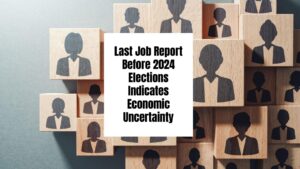US economy is like a big, complicated puzzle with lots of moving parts, influenced by things happening both here at home and around the world. Looking ahead to 2025, a few important things could really change how the economy works, bringing both good chances and tough times.
These things include the lasting effects of government help during tough times, the growing gap between how much people have and how much they earn, the possible impact of countries trying to protect their own businesses, changes in interest rates, and how the world's interconnectedness will shape things in the future. If we understand these factors, people and businesses can make smart choices to handle whatever the economy throws at us in the years to come.
Introduction: Changing Economic Climate
We live in a world of constant change. Economic conditions are never static, and the factors that drive them are always in flux. Over the last few years, we’ve seen a series of significant global events—from the pandemic to the war in Ukraine—that have rippled through the global economy, affecting everything from inflation and interest rates to commodity prices and the housing market. As we move towards 2025, it's important to be aware of the forces that could continue to influence the economy and potentially shape its future direction.
I find it fascinating to follow global economic trends. Even if you are not an investor in the traditional sense, understanding these trends impacts your daily life—the prices you pay for goods and services, the availability of jobs, and the overall well-being of your community.
US Economy in 2025: Critical Factors That Could Shape the Future
1. The Lingering Impact of Economic Stimulus
The global response to the pandemic included massive government spending and monetary policies aimed at stimulating the economy and mitigating the negative effects of lockdowns and supply chain disruptions. In the U.S., the government debt has more than doubled since 2019, reaching nearly $35 trillion. The Federal Reserve also played a significant role, injecting $5 trillion into the economy through various programs. This level of stimulus was extraordinary, perhaps resembling the scale of a mid-sized war.
This type of large-scale stimulus typically has a lingering effect on the economy. It can take several years for the full impact to work its way through the system. We’ve seen some of the effects already, such as increased consumer spending and robust economic growth. However, the long-term implications are still uncertain.
For example, the massive stimulus that occurred during World War II continued to fuel the U.S. economy throughout the 1950s and 1960s, leading to significant technological advancements, like jet engines. We could be facing a similar scenario today, where the 2020 stimulus continues to drive economic growth for some time to come.
2. The Inflated Wealth-to-Income Ratio
The economic stimulus had a significant impact on the wealth of American households. Since the start of the pandemic, household wealth has increased by about $47 trillion. This represents a 40% increase in just four to five years. This surge in wealth has led to a sharp increase in the wealth-to-income ratio. This ratio represents the total wealth of households relative to their disposable income.
Historically, this ratio has averaged around 550%. However, it has now reached 750%, a record high. This suggests that asset prices—such as stocks, real estate, and other investments—are inflated relative to income levels.
While a high wealth-to-income ratio can seem positive, it also carries a significant risk. If there is a sudden shift in economic conditions—like a sharp increase in interest rates or a decline in asset prices—it could lead to a rapid decline in household wealth.
For example, if the wealth-to-income ratio were to return to its historical average of 550%, it could potentially wipe out $30 to $40 trillion in wealth, potentially plunging the economy into a severe recession. This is a significant risk factor to keep in mind as we move towards 2025.
3. The Potential Impact of Protectionist Policies
In recent years, there’s been a growing trend toward protectionist policies, including trade tariffs and other restrictions on international trade. While some advocate that these policies protect domestic industries and jobs, they can also lead to higher prices for consumers and negatively impact economic growth.
I believe that a major shift toward protectionism—such as imposing high tariffs on imported goods from China or other trading partners—could create a severe economic disruption. It could effectively lead to a return to a more closed domestic economy with limited competition and potentially push us back toward a period of high inflation.
This type of scenario would likely lead to a surge in inflation, particularly for goods and services that are heavily reliant on imports. The Federal Reserve would likely respond by raising interest rates, potentially triggering a recession and further decline in asset prices. It's important to consider this potential impact when thinking about the economic outlook in 2025.
4. Fluctuations in Interest Rates
Interest rates play a crucial role in shaping the economy. The Federal Reserve, as the central bank of the U.S., manages interest rates to influence inflation, economic growth, and other economic variables.
The federal funds rate, which is the target rate that the Federal Reserve sets for banks to lend to each other, has increased significantly in recent years. However, recently, the Federal Reserve has begun to cut interest rates in response to easing inflationary pressures and growing concerns about a possible recession.
The Federal Reserve’s projection is that the federal funds rate could decline to as low as 2.9% by 2026. This is based on their current assessment of economic conditions. However, as I mentioned before, unexpected events, like shifts in the global economy or new trade policies, could alter their course.
These fluctuations in interest rates can have a significant impact on both consumers and businesses. For example, higher interest rates can increase borrowing costs for mortgages and business loans, potentially slowing down spending and investment. Lower interest rates can stimulate spending and investment. However, if interest rates fall too quickly, it can lead to a boom in sectors like real estate, potentially leading to another housing bubble.
The relationship between interest rates and the housing market is particularly interesting. The current supply and demand dynamics in the housing market are influencing home prices in many areas. However, as interest rates fall, more homeowners might be inclined to sell their homes and refinance at lower rates, potentially leading to an increase in housing supply.
5. The Role of Globalization
Globalization has been a driving force in the global economy for several decades. It has helped to lower the cost of goods and services by allowing businesses to access a global market for labor and resources. However, as the pandemic and other events highlighted, globalization also presents challenges. Supply chain disruptions, for example, can have significant consequences for businesses and consumers.
The pandemic and the war in Ukraine have temporarily disrupted global supply chains. However, the global economy is still largely interconnected. The availability and cost of imports will continue to play a significant role in shaping the U.S. economy.
I believe that globalization will continue to be a factor in shaping the U.S. economy, but its influence may be slightly diminished compared to the past. This is partly due to the disruptions that we’ve experienced in recent years. It's still a primary factor that impacts everything from prices to employment to economic stability.
6. The Potential for Technological Advancements
The potential for technological advancements is a significant factor that could impact the economy in 2025 and beyond.
I've been advocating for the establishment of a U.S. Sovereign Wealth Fund to invest in emerging industries such as artificial intelligence, fusion energy, quantum computing, biotechnology, and nanotechnology. Such a fund, funded through government borrowing or by the Federal Reserve, could potentially accelerate the development of these technologies.
These investments could lead to breakthroughs in various fields, from healthcare to energy production. They could also improve national security by ensuring that the U.S. remains a leader in technological innovation.
However, it's important to consider that even with a well-funded Sovereign Wealth Fund, the development of new technologies can be unpredictable. There’s no guarantee that the U.S. will be successful in every venture. It’s important to be prepared for the potential that some projects may not yield the desired results, and we need to understand and accept that possibility.
Conclusion:
The economy is a complex system influenced by a multitude of interacting factors. While we can analyze and attempt to predict future economic trends, it’s essential to acknowledge that the future is inherently uncertain.
The factors discussed in this article are just a few of the many that could have a significant impact on the economy in 2025. It's imperative to stay informed about these developments and their potential implications for individuals and businesses.
I believe that by staying informed about the forces that could shape the economy, we can be better prepared to manage risk and take advantage of opportunities. Paying attention to the trends and being aware of the challenges can help guide us through the uncertain economic terrain we’re likely to experience.
Recommended Read:
- Job Report Before 2024 US Elections Indicates Economic Uncertainty
- Economic Outlook 2024: Inflation Rate Falls to 2.4% in September
- Will Job Growth Surge Impact the Housing Market?
- Inflation Trends 2024: Are We Winning the Battle Against Rising Prices?
- Inflation Drops to 3-Year Low as Fed Eyes Interest Rate Cuts
- US in Economic Crisis: Causes, Effects, and Preparedness Strategies
- How Strong is the US Economy Today in 2024?
- Economic Forecast: Will Economy See Brighter Days in 2024?
- Will the Economy Recover in 2024?
- Economic Forecast for Next 10 Years
- Economic Forecast for the Next 5 Years
- How Close Are We to Total Economic Collapse?


